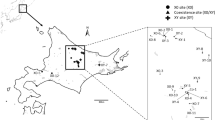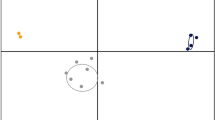Abstract
The extremely high rate of karyotypic evolution that characterizes the shrews of the Sorex araneus group makes this group an exceptionally interesting model for population genetics and evolutionary studies. Here, we attempted to map 46 microsatellite markers at the chromosome arm level using flow-sorted chromosomes from three karyotypically different taxa of the Sorex araneus group (S. granarius and the chromosome races Cordon and Novosibirsk of S. araneus). The most likely localizations were provided for 35 markers, among which 25 were each unambiguously mapped to a single locus on the corresponding chromosomes in the three taxa, covering the three sexual chromosomes (XY1Y2) and nine of the 18 autosomal arms of the S. araneus group. The results provide further evidence for a high degree of conservation in genome organization in the S. araneus group despite the presence of numerous Robertsonian rearrangements. These markers can therefore be used to compare the genetic structure among taxa of the S. araneus group at the chromosome level and to study the role of chromosomal rearrangements in the genetic diversification and speciation process of this group.
Similar content being viewed by others
References
Arnason U, Janke A (2002) Mitogenomics analyses of eutherian relationships. Cytogenet Genome Res 96: 20–32.
Balloux F, Ecoffey E, Fumagalli L, Goudet J, Wyttenbach A, Hausser J (1998) Microsatellite conservation, polymorphism, and GC content in shrews of the genus Sorex (Insectivora, Mammalia). Mol Biol Evol 15: 473–475.
Balloux F, Brünner H, Lugon-Moulin N, Hausser J, Goudet J (2000) Microcatellite can be misleading: an empirical and simulation study. Evolution 54: 1414–1422.
Basset P, Yannic G, Hausser J (2006) Genetic and karyotypic structure in the shrews of the Sorex araneus group: Are they independent? Mol Ecol (In press).
Brünner H, Lugon-Moulin N, Hausser J (2002) Alps, genes, and chromosomes: their role in the formation of species in the Sorex araneus group (Mammalia, Insectivora), as inferred from two hybrid zones. Cytogenet Genome Res 96: 85–96.
Coyne JA, Orr AH (2004) Speciation. Sunderland, Mass.: Sinauer Associates.
Doležel J, Kubalákova M, Bartoš J, Macas J (2004) Flow cytogenetics and plant genome mapping. Chromosom Res 12: 77–91.
Douady CJ, Chatelier PI, Madsen O et al. (2002) Molecular phylogenetic evidence confirming the Eulipotyphla concept and in support of hedgehogs as the sister group to shrews. Mol Phylogenet Evol 25: 200–209.
Ferguson-Smith MA (1997) Genetic analysis by chromosome sorting and painting: phylogenetic and diagnostic applications. Eur J Hum Genet 5: 253–265.
Fumagalli L, Taberlet P, Stewart D, Gielly L, Hausser J, Vogel P (1999) Molecular phylogeny and evolution of Sorex shrews (Soricidae: Insectivora) inferred from mitochondrial DNA sequence data. Mol Phylogenet Evol 11: 222–235.
Ibrahim SF, van den Engh G (2004) High-speed chromosome sorting. Chromosom Res 12: 5–14.
Lugon-Moulin N, Brünner H, Wyttenbach A, Hausser J, Goudet J (1999) Hierarchical analyses of genetic differentiation in a hybrid zone of Sorex araneus (Insectivora: Soricidae). Mol Ecol 8: 419–431.
Lugon-Moulin N, Balloux F, Hausser J (2000) Genetic differentiation of common shrew (Sorex araneus) populations among different alpine valleys revealed by microsatellites. Acta Theriol 45: 103–117.
Murphy WJ, Pevzner PA, O'Brien SJ (2004) Mammalian phylogenomics comes of age. Trends Genet 20: 631–639.
Navarro A, Barton NH (2003) Accumulating postzygotic isolation genes in parapatry: a new twist on chromosomal speciation. Evolution 57: 447–459.
Noor MAF, Grams KL, Bertucci LA, Reiland J (2001) Chromosomal inversions and the reproductive isolation of species. Proc Natl Acad Sci USA 98: 12084–12088.
Nowak RM (1991) Walker's Mammals of the World, 5th edn. Baltimore, MD: Johns Hopkins University Press.
O'Brien SJ, Menotti-Raymond M, Murphy WJ et al. (1999) The promise of comparative genomics in mammals. Science 286: 458–481.
O'Brien SJ, Eizirik E, Murphy WJ (2001) On choosing Mammalian genomes for sequencing. Science 292: 2264–2266.
Pack SD, Borodin PM, Serov OL, Searle JB (1993) The X-autosome translocation in the common shrew (Sorex araneus L.): late replication in female somatic cells and pairing in male meiosis. Chromosoma 102: 355–360.
Pack SD, Kolonin MG, Borodin PM, Searle JB, Serov OL (1995) Gene mapping in the common shrew (Sorex araneus; Insectivora) by shrew–rodent cell hybrids: chromosome localization of the loci for HPRT, TK, LDHA, MDH1, G6PD, PGD, and ADA. Mamm Genome 6: 784–787.
Panithanarak T, Hauffe HC, Dallas JF, Glover A, Ward RG, Searle JB (2004) Linkage-dependent gene flow in a house mouse chromosomal hybrid zone. Evolution 58: 184–192.
Pennisi E (2004) More genomes, but shallower coverage. Science 304: 1227.
Rieseberg LH (2001) Chromosomal rearrangements and speciation. Trends Ecol Evol 16: 351–358.
Rieseberg LH, Whitton J, Gardner K (1999) Hybrid zones and the genetic architecture of a barrier to gene flow between two sunflowers species. Genetics 152: 713–727.
Samonte RV, Eichler EE (2002) Segmental duplication and the evolution of the primate genome. Nat Rev Genet 3: 65–72.
Sargan DR, Yang F, Squire M, Milne BS, O'Brien PCM, Ferguson-Smith MA (2000) Use of flow-sorted canine chromosomes in the assignment of canine linkage, radiation hybrid, and syntenic groups to chromosomes: refinement and verification of the comparative chromosome map for dog and human. Genomics 69: 182–195.
Searle JB, Wójcik JM (1998) Chromosomal evolution: the case of Sorex araneus. In Wójcik JM, Wolsan M, eds. Evolution of Shrews. Bialowieza: Mammal Research Institute, Polish Academy of Sciences, pp. 219–262.
Searle JB, Fedyk S, Fredga K, Hausser J, Volobouev VT (1991) Nomenclature for the chromosomes of the common shrew Sorex araneus. Mém Soc Vaud Sci Nat 19: 13–22.
Sharman GB (1956) Chromosomes of the common shrew. Nature 177: 941–942.
Telenius H, Pelmear AH, Tunnacliffe A et al. (1992) Cytogenetic analysis by chromosome painting using DOP PCR amplified flow sorted chromosomes. Gene Chromosomes Cancer 4: 257–263.
Thomas EE, Srebro N, Sebat J et al. (2004) Distribution of short paired duplications in mammalian genomes. Proc Natl Acad Sci USA 101: 10349–10354.
Volobouev VT (1989) Phylogenetic relationships of the Sorex araneus–arcticus species complex (Insectivora, Soricidae) based on high-resolution chromosome analysis. J Heredity 80: 284–290.
Volobouev VT, Catzeflis, F (1989) Mechanisms of chromosomal evolution in three European species of the Sorex araneus– arcticus group (Insectivora: Soricidae). Z zool Syst Evolut-forsch 27: 252–262.
Wójcik JM, Searle JB (1988) The chromosome complement of Sorex granarius–the ancestral karyotype of the common shrew (Sorex araneus)? Heredity 61: 225–229.
Wójcik JM, Ratkiewicz M, Searle JB (2002) Evolution of the common shrew Sorex araneus: chromosomal and molecular aspects. Acta Theriol 47: 139–167.
Wójcik JM, Borodin PM, Fedyk S, et al. (2003) The list of the chromosome races of the common shrew Sorex araneus (updated 2002). Mammalia 67: 169–178.
Wyttenbach A, Favre L, Hausser J (1997) Isolation and characterization of simple sequence repeats in the genome of the common shrew. Mol Ecol 6: 797–800.
Yang F, Carter NP, Shi L, Ferguson-Smith MA (1995) A comparative study of karyotypes of muntjacs by chromosome painting. Chromosoma 103: 642–652.
Yang F, O'Brien PCM, Milne BS et al. (1999) A complete comparative chromosome map for the dog, red fox, and human and its integration with canine genetic maps. Genomics 62: 189–202.
Zhdanova NS, Fokina VM, Balloux F et al. (2003) Current cytogenetic map of the common shrew, Sorex araneus L.: localization of 7 genes and 4 microsatellites. Mammalia 68: 285–293.
Author information
Authors and Affiliations
Corresponding author
Rights and permissions
About this article
Cite this article
Basset, P., Yannic, G., Yang, F. et al. Chromosome localization of microsatellite markers in the shrews of the Sorex araneus group. Chromosome Res 14, 253–262 (2006). https://doi.org/10.1007/s10577-006-1041-x
Received:
Accepted:
Published:
Issue Date:
DOI: https://doi.org/10.1007/s10577-006-1041-x




